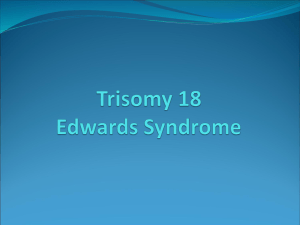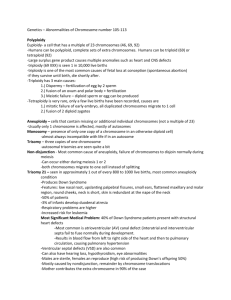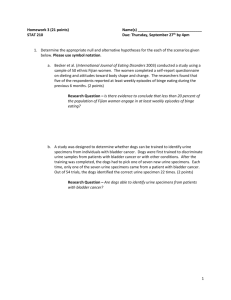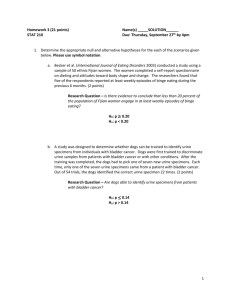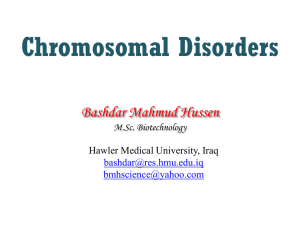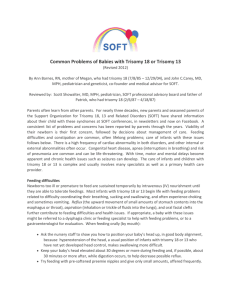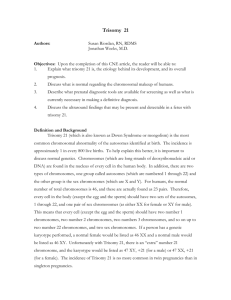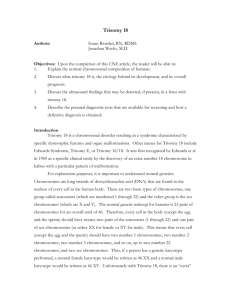infertility related to x-trisomy in a labrador retriever bitch
advertisement
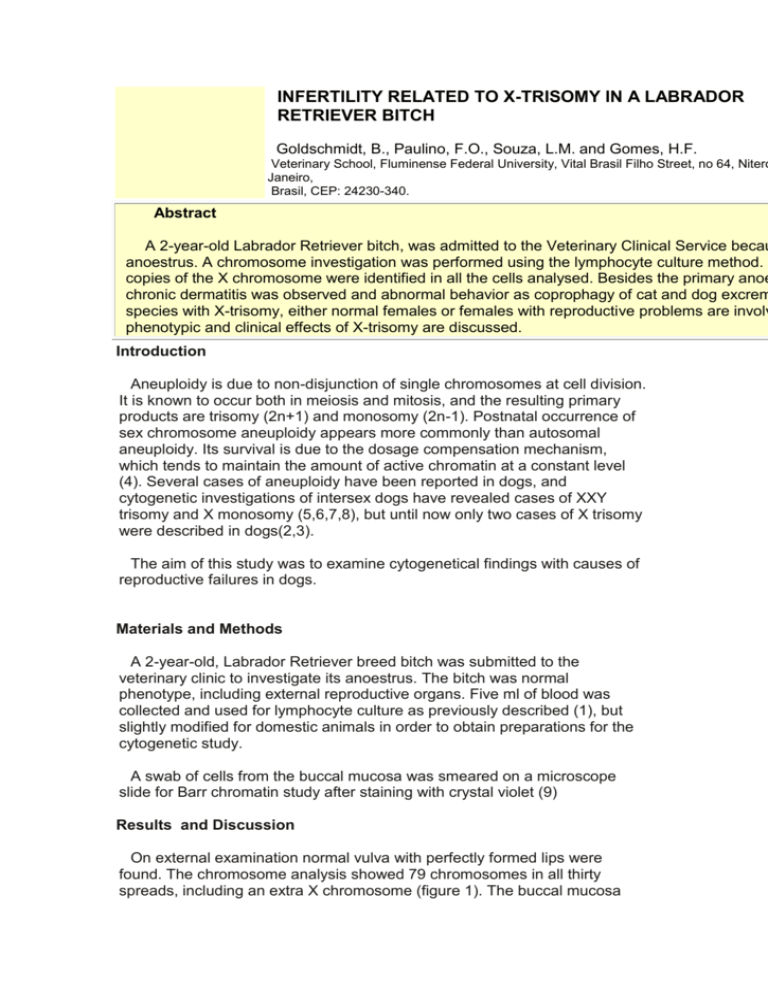
INFERTILITY RELATED TO X-TRISOMY IN A LABRADOR RETRIEVER BITCH Vol. 58 (4) 2003 Goldschmidt, B., Paulino, F.O., Souza, L.M. and Gomes, H.F. Veterinary School, Fluminense Federal University, Vital Brasil Filho Street, no 64, Niteró Janeiro, Brasil, CEP: 24230-340. Abstract A 2-year-old Labrador Retriever bitch, was admitted to the Veterinary Clinical Service becau anoestrus. A chromosome investigation was performed using the lymphocyte culture method. copies of the X chromosome were identified in all the cells analysed. Besides the primary anoe chronic dermatitis was observed and abnormal behavior as coprophagy of cat and dog excrem species with X-trisomy, either normal females or females with reproductive problems are involv phenotypic and clinical effects of X-trisomy are discussed. Introduction Aneuploidy is due to non-disjunction of single chromosomes at cell division. It is known to occur both in meiosis and mitosis, and the resulting primary products are trisomy (2n+1) and monosomy (2n-1). Postnatal occurrence of sex chromosome aneuploidy appears more commonly than autosomal aneuploidy. Its survival is due to the dosage compensation mechanism, which tends to maintain the amount of active chromatin at a constant level (4). Several cases of aneuploidy have been reported in dogs, and cytogenetic investigations of intersex dogs have revealed cases of XXY trisomy and X monosomy (5,6,7,8), but until now only two cases of X trisomy were described in dogs(2,3). The aim of this study was to examine cytogenetical findings with causes of reproductive failures in dogs. Materials and Methods A 2-year-old, Labrador Retriever breed bitch was submitted to the veterinary clinic to investigate its anoestrus. The bitch was normal phenotype, including external reproductive organs. Five ml of blood was collected and used for lymphocyte culture as previously described (1), but slightly modified for domestic animals in order to obtain preparations for the cytogenetic study. A swab of cells from the buccal mucosa was smeared on a microscope slide for Barr chromatin study after staining with crystal violet (9) Results and Discussion On external examination normal vulva with perfectly formed lips were found. The chromosome analysis showed 79 chromosomes in all thirty spreads, including an extra X chromosome (figure 1). The buccal mucosa smears showed nuclei with two Barr bodies, indicating that the extra chromosome was an X. (figure 2). Therefore, the karyotype was designated as 79,XXX. This abnormality is relatively frequent in humans, but a high proportion of women with X trisomy are fertile (10). In cattle, X trisomy has been widely described (11, 12, 13, 14) and in horses, eight cases of trisomy have been described (15,16, 17). A case of X-trisomy in the mouse was also reported (18) associated with infertility, due to small ovaries containing only primordial and primary follicles. In dogs, only two cases have been reported with X trisomy; one associated with gonadal disgenesis (2) and, the second described in a 5years-old mixed breed bitch, that was infertile and with a congenital absence of some premolar and molar teeth (3). Other than extra X inativation, the X Figure 1 - Metaphase presenting three X chromosomes arrows trisomy cell lineage may produce a failure in the organogenesis of the ovarian tissue correlated with anestrus and inibition of germ cells to be meiotic. The phenotypic effects of the chromosome aberrations range from those which cause considerable reductions in fertility to those which are statistically demonstrable only when extensive numbers of aberration carriers are investigated. Those causing considerable fertility reduction do not usually present any risk since they are eliminated fairly quickly by artificial selection. It is necessary to identify and select the carriers of chromosome abnormalities to achieve a correct diagnosis of reproductive problems. Figure 2 - The arrows indicate two Barr bodies represe inactivated X chromosomes in the trisomic bitch. LINKS TO OTHER ARTICLES IN THIS ISSUE References 1. Moorhead, P.S., Nowelli, P.C., Nellman, W.J. et al.: Chromosome preparations of leucocytes cultures from human peripheral blood. Exp. Cell Res., 20: 613-161, 1960. 2. Johnston, S.D., Buoen, L.C., Weber, A.F. and Madl, J.E.: X trisomy in a airedale bitch with ovarian dysplasia and primary anestrus. Theriogenology, 24: 597-606, 1985. 3. Switonski, M., Godynicki, S., Pienkowska, A. et al.: X trisomy in an infertile bitch: Cytogenetic, anatomic and histologic studies. J. Hered. 91: 149-150, 2000. 4. Lyon, M.F.: Gene action in the X-chromosome of the mouse (Mus musculus). Nature, 190: 372-373, 1961. 5. Mellink, C.H.M. and Bosma, A.A.: The karyotype of the domestic dog (Canis familiaris). In: Halnan C.R.E., Ed.: Cytogenetics of Animals. Walligford: CAB International, pp.151-158, 1988. 6. Meyers-Wallen, V.N.: (1993) Genetic of sexual differentiation and anomalies in dogs and cats. J. Reprod. Fertil., 47 (suppl.): 441-452, 1993. 7. Goldschmidt, B., El-Jaick, K.B., Souza, L.M., Carvalho, E.C.Q., Moura, V.L.S. and Benevides Filho, I.M.: Cryptorchidism associated with 78,XY/79,XXY mosaicism in dog. Israel J. Vet. Med., 56(2): 56-58, 2001. 8. Goldschmidt, B., El-Jaick, K.B., Souza, L.M., Abreu, C.L.C. and Pinho, T.G.: Mosaicism 78,XX/77,XO in a Bull Terrier of small stature. Israel J.Vet. Med., 57(1), 39-40, 2002. 9. Moore, K.L. and Barr, M.L.: Smears from the oral mucosa in the detection of chromosomal sex. Lancet ii: 57, 1955. 10. Guichet, A., Briault, S., Moraine, C.L. and Turleau, C.: Trisomy X: ACLF (Association des Cytogeneticiens de Langue Francaise) retrospective study. Ann Genet 39: 117-122, 1996. 11. Basrur, P.K., Gilman, J.P.W. and Mcsherry, B.N.: Cytological observations on a bovine lynphosarcoma. Nature 20, 308-311.J. Am. Vet. Med. Assoc. 179(8): 808—811, 1964. 12. Rieck, G.W., Hohn, H. and Herzog, A.: X-trisomy in cattle with signs of familial disposition for meiotic disturbances. Cytogenetics, 9960, 401-409, 1970. 13. Norberg, H.S., Refsdal, A.O., Garm, O.N. and Nes, N.: A case-report on X-trisomy in cattle. Hereditas, 82(1): 69-72, 1976. 14. Moreno-Millan, M., Delgado, J.V. and Garcia, A.F.: X-trisomy in Friesian cow with continuous oestrus. Vet. Rec., 121(8): 167-168, 1987. 15. Chandley, A.C., Fletcher, J., Rossdale, P.D., Peace, C.K., Ricketts, S.W., McEnery, R.J., Thorne, J.P., Short, R.V. and Allen, W.R.: Chromosome abnormalities as a cause of infertility in mares. J. Reprod. Fert. (Suppl.) 23: 377-383, 1975. 16. Bouen, L.C., Seguin, B.E., Weber, A.F. and Shoffner, R.N.: X-trisomy karyotype and associated fertility in a Holstein heifer. 1983. 17. Moreno-Millan, M., Delgado, J.V. and Castillo, L.G.: An intersex horse with X chromosome trisomy. Vet. Rec., 124(7): 169-170, 1989. 18. Endo, A. and Watanabe, T.: A case of X-trisomy in the mouse. Cytogenet. Cell Genet., 52(1-2): 98-99, 1989. 1.

